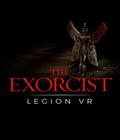As a series, "The Exorcist" has never been about jump-scares and sudden fright. Its horror is steeped in general unease and the thought of demons possessing one's body and making it do inhuman things. It also doesn't help that the act of exorcism is vehemently denied by the church, despite acknowledgements that the practice exists. At the time of the movie's debut, it shocked audiences and remains one of the most influential horror movies of all time. With VR currently serving as a hotbed of horror experiences, it comes as no surprise that The Exorcist: Legion VR is a thing. However, despite the hang-ups one may have about licensed titles in general, this is a short but moving experience.
The player starts off as a detective in the Boston police department. You begin each of the five episodes in the station and are then directed to one of five different crime scenes, one per episode. You get a ton of background information before entering each case, and upon entering the location, you're set on finding all of the clues available in the various crime scenes. Eventually, the episode leads with you confronting the demon responsible for the carnage in the area, and while each episode is self-contained, it soon becomes clear that every incident is connected. This is especially true at the episode's epilogue, where you always get a mysterious letter and package with an artifact or clue that leads you to the next episode.
For the most part, you'll go around each area trying to solve a litany of puzzles in order to open up the next area and start the process again or try to exorcise the demon. For the most part, you'll use a combination of the items in each room along with the tools in your exorcism kit, which is obtained in the first episode. The oil lamp may not provide a tremendous amount of light, but it's good at revealing any demonic presence or anything affected by one. Both salt and holy water vials are used for purification, with the latter also being good for putting out demonic fires. The crucifix is your real means of banishment, however, and it's one you'll likely have out at all times due to how well it acts as a barrier between you and everything else.
Though linear in nature, the game gives you some freedom to play around in the environment and do things that aren't necessary for the main goal. There are a good number of puzzles that, while more difficult than the ones specifically for the main questline, reward you with optional upgrades to the tools in your exorcism kit. There's also a lot of interactive elements. The novelty of being able to mess around with almost everything in the world still hasn't grown old, so being able to play around with things like a dollhouse or rocking chair — with realistic physics no less — makes for a good respite from the scares you'll face.
In regards to that, the game stays true to what's established by the franchise in that it is more reliant on atmospheric dread rather than jump-scares. Although the latter still exists, it is very few and far between, with objects suddenly falling from places more often than creatures appearing out of nowhere. Instead, the game relies on seeing disturbing things, like severed pig heads and corpses and bugs crawling out from places. Furniture mysteriously moving on its own and statues appearing out of nowhere are accompanied by the rising crescendo of the score and various whispers to enhance the level of unease that never seems to let up, even after you vanquish the demon at the end of an episode.
About the only knock against the game is that it is relatively short. Granted, this affects almost every VR title, as people are still trying to figure out the sweet spot for game length, but the episodic nature of the experience means that it's more noticeable. With each episode running the length of a standard half-hour TV show, the lead-up to each demon encounter can feel quick, but things get considerably longer if you take your time trying to power-up your exorcism tool kit and generally playing around with every interactive element in the environment.
The Exorcist's look and sound are spot-on. Despite the lower resolution of the PSVR headset, everything from the demons to the environments and the incidental playthings are rendered wonderfully. Even the books and other legible scraps are done well; the text is very clear, which is something of a prerequisite since you have to read some of the reports instead of having scrolling text or an audio monologue do that for you. Speaking of audio, it does well in contributing to the growing unease that permeates each episode, and the voice acting is good enough, despite a few rough performances here and there. Camera-wise, the game provides both smooth turning movements and segmented ones, but the movement is slow enough that smooth turns don't induce motion sickness as quickly as in other games.
The Exorcist: Legion VR is easily one of the more effective horror games on the platform to date. Its reliance on relative unease rather than jump-scares makes it stand out from other horror games on the platform, while the number of challenging puzzles gives the title some real substance. While there's no doubt that more effective horror games can hit VR in the near future, The Exorcist is one of the better ones that you can find today.
Score: 8.0/10
More articles about The Exorcist: Legion VR











 The Exorcist: Legion VR is a fully interactive, episodic story set in the world created by horror maestro William Peter Blatty.
The Exorcist: Legion VR is a fully interactive, episodic story set in the world created by horror maestro William Peter Blatty.







